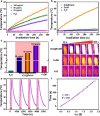Hyaluronic acid modified covalent organic polymers for efficient targeted and oxygen-evolved phototherapy
- PMID: 33407506
- PMCID: PMC7789517
- DOI: 10.1186/s12951-020-00735-x
Hyaluronic acid modified covalent organic polymers for efficient targeted and oxygen-evolved phototherapy
Abstract
The integration of multiple functions with organic polymers-based nanoagent holds great potential to potentiate its therapeutic efficacy, but still remains challenges. In the present study, we design and prepare an organic nanoagent with oxygen-evolved and targeted ability for improved phototherapeutic efficacy. The iron ions doped poly diaminopyridine (FeD) is prepared by oxidize polymerization and modified with hyaluronic acid (HA). The obtained FeDH appears uniform morphology and size. Its excellent colloidal stability and biocompatibility are demonstrated. Specifically, the FeDH exhibits catalase-like activity in the presence of hydrogen peroxide. After loading of photosensitizer indocyanine green (ICG), the ICG@FeDH not only demonstrates favorable photothermal effect, but also shows improved generation ability of reactive oxygen species (ROS) under near-infrared laser irradiation. Moreover, the targeted uptake of ICG@FeDH in tumor cells is directly observed. As consequence, the superior phototherapeutic efficacy of the targeted ICG@FeDH over non-targeted counterparts is also confirmed in vitro and in vivo. Hence, the results demonstrate that the developed nanoagent rationally integrates the targeted ability, oxygen-evolved capacity and combined therapy in one system, offering a new paradigm of polymer-based nanomedicine for tumor therapy.
Keywords: Covalent organic polymers; Hypoxia tumor; Photodynamic therapy; Photothermal therapy; Targeted therapy.
Conflict of interest statement
The authors declare that they have no competing interests.
Figures







References
MeSH terms
Substances
Grants and funding
LinkOut - more resources
Full Text Sources
Other Literature Sources
Research Materials

